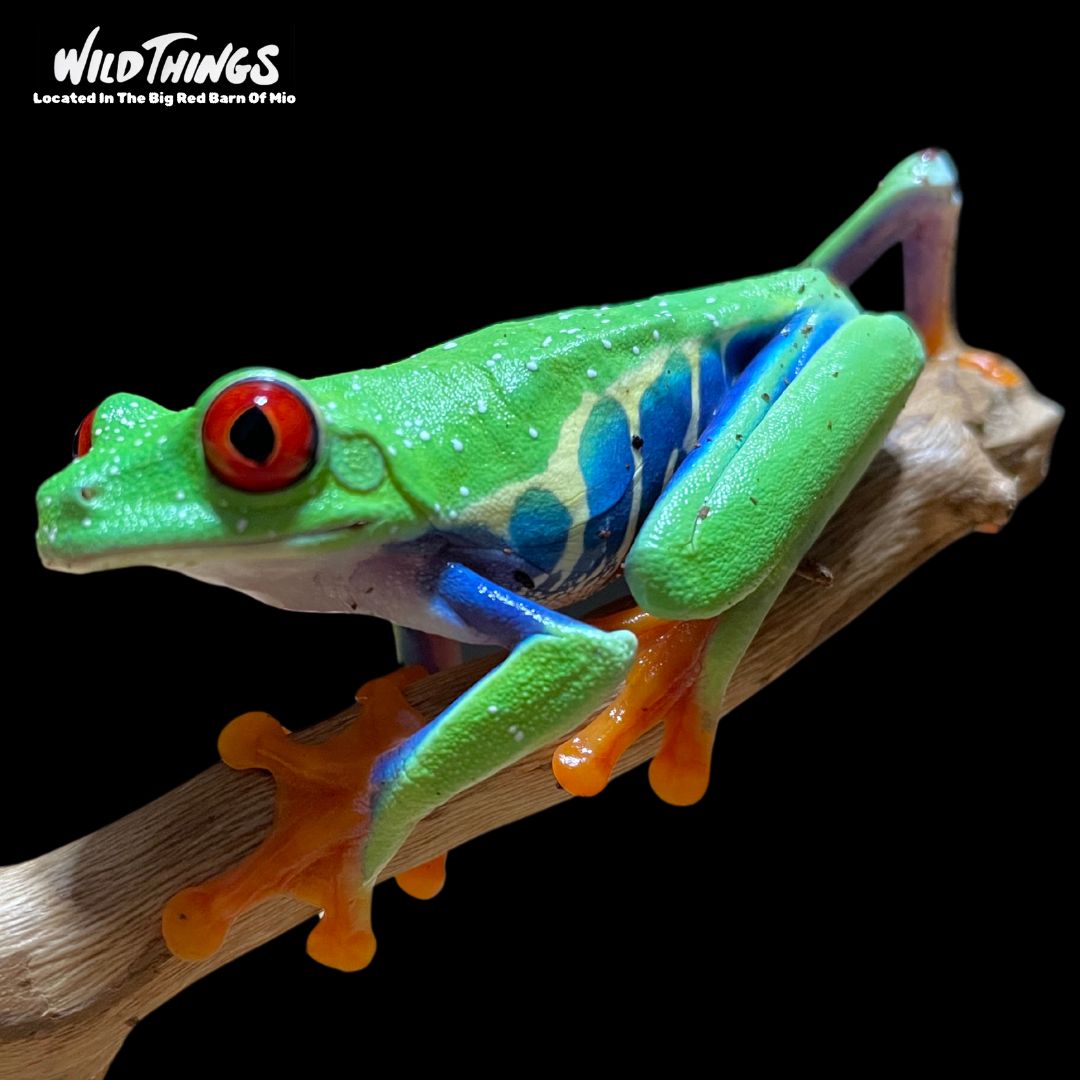AuSable River Outdoors
Red Eyed Tree Frog
Red Eyed Tree Frog
Couldn't load pickup availability
Species: Red Eyed Tree Frog
Scientific Name: Agalychnis Callidryas
Origin: The red eyed tree frog is a species of tree frog native to eastern Australia; ranging from south of Sydney (Nowra area) to Proserpine in mid-northern Queensland
Lifespan: 5 years in the wild, 8 to 12 years in captivity
Size: 1.5-2.75 Inches
Enclosure Type: You need a tall terrarium, placing branches strategically to give your frogs lots of climbing space. Live or fake plants are welcome, depending on your preference. “Jungle vines” are helpful as well. Between the vines, plants, and branches, your main goal is to provide lots of claiming areas.
Enclosure Size: one that is at least 18″ in height. An 18″ x 18″ x 24″ terrarium is recommended, if possible, which will hold up to 4 treefrogs. A 12″ x 12″ x 18″ will work too, holding between 1 – 2 frogs. Treefrogs are social creatures, so it’s best to keep at least two of them together in the same enclosure.
Substrate: Choosing a substrate really depends on what you’re trying to accomplish. For a basic setup using fake plants, try using a coco fiber substrate. Adding coco husk chips and sphagnum moss into the coco fiber substrate is another option but certainly not required. Should you decide to set up a vivarium, where live plants are being utilized, try an ABG mix; something designed for growing plants. Using an ABG mix works best when you include microfauna and leaf litter, which is by no means a requirement in caring for Red-Eyed Tree Frogs
Décor: Driftwood or artificial branches are aesthetically pleasing and the red eyed tree frog can climb on them. You can set up several branches and pieces of driftwood within the tank to give your frog a variety of places to climb. Pet stores have a variety of red eyed tree frog tank decorations, such as hollow logs and artificial branches. The hollow logs are great hiding places for your frog. You can also add hollow rocks for them to hide in. In addition, rocks add a great textural mix with the logs in your tank.
Water: Place a small, shallow water dish in the cage. They’re not fantastic swimmers and they don’t require a lot of water. In terms of the water dish, most will suffice, so long as the water is shallow. Be sure to keep the water shallow within the dish. They will drink water droplets that collect on the leaves within the terrarium, the water dish is just for soaking their skin.
Temperature: The recommended temperature ranges from the upper 70s to the mid-80s during the day. At nighttime, the heat can fall to the low 70s without any worry. This means you need a heater. A basking lamp is recommended. It makes the top portion of the terrarium around 85 degrees Fahrenheit. Towards the bottom of the enclosure, the temperature drops to the upper 70s. Whether you use a basking lamp or a heating pad, just do your best to create a temperature gradient within their enclosure. This will give your Red-Eyed Tree Frogs the option to move to a warmer or cooler portion of the terrarium as they see fit. It’s always a good idea to pair a heating device with a thermostat. A thermostat will help regulate the temperature but shut off the heater (lamp, heat emitter, heat mat, etc.) when the temperature reaches a certain degree.
Humidity: Red-Eyed Tree Frogs enjoy a moderate humidity level with a nice spike in humidity once a day. That means raising the humidity up to 80% or 90% each day. You don’t need to keep it that high all the time though. You can automate this process by getting misting systems or installing foggers with a separate Hydrotherm to start and stop the device as needed. Unless you’re having a hard time keeping the humidity within the recommended parameters, these products aren’t needed. A simple spray bottle will suffice. Mist as often as you need to always keep the humidity above 50%. Each day, provide a heavy misting to raise the humidity to around 90%.
Lighting: Red eyed tree frogs require a constant day and night cycle. Should you happen to place their enclosure in a room with little or no sunlight from a window, then you need to give them a light. A day and night cycle can consist of 12 – 14 hours of light and 10 – 12 hours of dark. Another reason you may need lighting is for live plants. Special lighting is not needed for the frogs, but certain plant life needs a grow light. A low-powered LED grow light is recommended
Type Of Diet: This arboreal frog species is a carnivore, and it feeds mostly on insects.
Types Of Food: Flies, crickets, moths, grasshoppers, and even smaller frogs. Tadpoles prefer eating pinhead crickets and fruit flies.
Feeding Schedule: Adult frogs should be fed every other night with three to six crickets or other food items. Juvenile frogs should be fed every night with loaded or supplement dusted insects. They generally require more food to grow healthy. Provide your pet red eyed tree frog with fresh water daily.
Supplements: To keep your red-eyed tree frog healthy, consider supplementing its diet with Vitamin D3, calcium, and multivitamin supplements123.
Share

